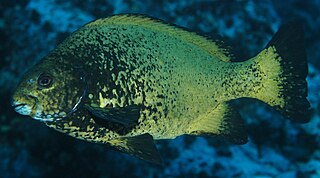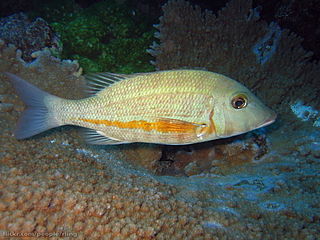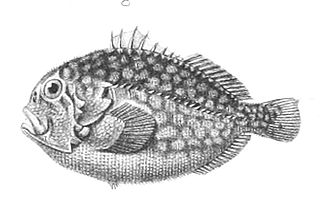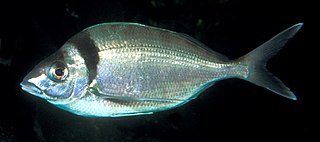
Cheilodactylidae, commonly called morwongs but also known as butterfish, fingerfins, jackassfish, sea carp, snappers, and moki, is a family of marine ray-finned fish. They are found in subtropical oceans in the Southern Hemisphere. The common name "morwong" is also used as a name for several unrelated fish found in Australian waters, such as the painted sweetlips. The classification of the species within the Cheilodactylidae and the related Latridae is unclear.

Cirrhitidae, the hawkfishes, are a family of marine perciform ray-finned fishes found in tropical seas and which are associated with coral reefs.

Hexagrammidae, the greenlings, is a family of marine ray-finned fishes belonging to the suborder Cottoidei in the order Scorpaeniformes. These fishes are found in the North Pacific Ocean.

Chironemus is a genus of marine ray finned fish, commonly known as kelpfishes, belonging to the family Chironemidae. They are found in the temperate waters of the Southern Pacific Ocean.

Aplodactylus is a genus of marine ray-finned fishes, commonly known as marblefishes or sea carps. It is the only genus in the monogeneric family, Aplodactylidae. The fishes in this genus are found in the south eastern Indian Ocean and the southern Pacific Ocean.

The sea chubs, also known as rudderfish and pilot fish and in Hawaiian as enenue or nenue, are a family, Kyphosidae, of fishes in the order Perciformes native to the Atlantic, Indian and Pacific Oceans usually close to shore in marine waters.

Lethrinidae are a family of ray-finned fishes belonging to the order Spariformes commonly known as emperors, emperor breams, and pigface breams.

Latridae commonly called trumpeters, is a family of marine ray-finned fish. They are found in temperate seas in the Southern Hemisphere. The classification of the species within the Latridae and the related Cheilodactylidae is unclear.They are fished commercially and for sport.

Pholidae is a family of marine ray-finned fishes, known as gunnels, in the scorpaeniform suborder Zoarcoidei. These are fishes of the littoral zone and are mainly found in North Pacific Ocean, with two species found in the North Atlantic Ocean and Arctic Ocean.

Peristediidae, the armored sea robins or armoured gurnards, is a family of ray-finned fishes belonging to the suborder Platycephaloidei in the order Scorpaeniformes. They are found in the deep water in the tropical and warm temperate of the world's oceans.

Caesionidae, the fusiliers, are a family of marine ray-finned fishes in the order Perciformes. The family includes about 23 species. They are related to the snappers, but adapted for feeding on plankton, rather than on larger prey. They are found at reefs in the Indo-Pacific and in the Red Sea.

Bembridae, the deep-water flatheads, are a family of bottom-dwelling ray-finned fishes. They are found in the Indian and western Pacific Oceans.

Caracanthus, the coral crouchers, or orbicular velvetfishes, are a genus of ray-finned fishes. They live in coral reefs of the tropical Indo-Pacific. This genus is the only member of the monotypic subfamily Caracanthinae, part of the family Scorpaenidae.

Pleurogrammus is a genus of ray-finned fishes belonging to the family Hexagrammidae, the greenlings, known as Atka mackerels. These fishes are found in the northwestern Pacific Ocean.

Hoplichthys, the ghost flatheads, is a genus of marine ray-finned fishes native to the Indian and Pacific Oceans. This genus is the only member of the family Hoplichthyidae.

Nemadactylus is a genus of marine ray-finned fish, traditionally regarded as belonging to the family Cheilodactylidae, the members of which are commonly known as morwongs. They are found in the South Atlantic, Indian and South Pacific Oceans.

Apsilus is a small genus of marine ray-finned fish, snappers belonging to the family Lutjanidae. The two species within the genus are native to the Atlantic Ocean,

Morwong is a genus of marine ray-finned fish traditionally classified as a subgenus within the genus Cheilodactylus and as belonging to the family Cheilodactylidae found in oceans off Australia and New Zealand. They were formerly included in the genus Cheilodactylus in family Cheilodactylidae, but based on genetic and morphological analyses they have strongly suggested that the genus Morwong is a valid genus and should be placed in the family Latridae.

The Serraninae is a subfamily of perciform ray-finned fishes in the family Serranidae. It is made up of ten genera and 87 species.

Opisthocentrinae is a subfamily of marine ray-finned fishes, classified within the family Stichaeidae, the pricklebacks or shannies. These fishes are found in the North Pacific Ocean.




















